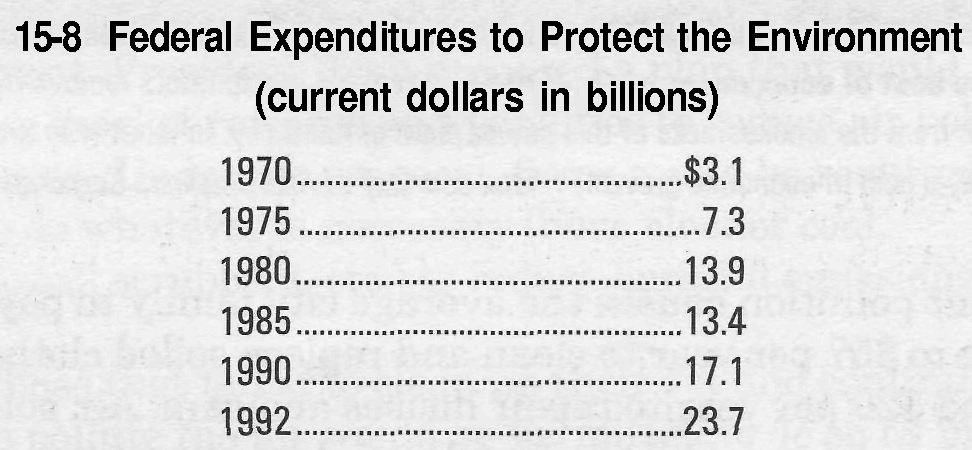
- •15.1. Urban Problems
- •15.2. What Can Be Done?
- •15.3. Poverty in America
- •15.4. Who are the Poor?
- •15.5. The Health-Care Crisis: An Overview
- •15.6. How Can America's Health-Care System Be Improved?
- •15.7. Farmers and their Problems
- •15.8. Economic Sources of the Farm Problem
- •15.9. The Global Connection
- •15.10. Federal Farm Aid
- •15.11. The 1990s and Beyond
- •15.12. Economic Growth and the Environment
- •15.13. Protecting the Environment
- •15.14. Air Pollution
- •15.15. Water Pollution
- •15.16. Land Pollution
- •15.17. The Economic Results of Regulation
- •15.18. The Twin Deficits
15.13. Protecting the Environment
For much of America's history, the country's population was so small and its area so vast that there seemed to be little need to worry about polluting the waters or ruining the land. If the soil in one place was "exhausted" or the waters polluted, the solution was simply to move on.
By the mid-20th century, however, that was no longer possible. The air over urban and industrial centers had become foul and the waters filthy, but moving was no longer practical.
Nor would free market forces end pollution. As noted earlier, pollution is an externality. The costs of cleaning up the damage caused by pollution do not naturally fall on those who cause it. Though many companies acting as good citizens tried to protect the environment, there was little economic incentive for them to do so.
It fell to government to protect the environment. Starting in the 1960s a series of laws was enacted that has done much to protect the fragile environment. To meet standards set by these laws, in 1992 government spent $23.7 billion and total expenditures by government and business, according to the EPA, were over $100 billion. Although opinions differ about the effectiveness of government intervention, according the 1993 Economic Report of the President air pollutants decreased significantly, between 26 and 61 percent depending on the pollutant, between 1970 and 1989. And industrial discharges of key water pollutants declined 90 percent between the mid-170s and mid-1980s.
Government efforts to control pollution have taken three forms: direct regulation, effluent fees, and tax credits.
• Direct regulation refers to government rules to protect the environment. Laws against burning waste in incinerators, dumping sewage in a river, and banning particular pesticides (such as DDT) are examples of this form of pollution control. Those who fail to obey government regulations are subject to fines, imprisonment, or both.
• Effluent fees are charges levied on polluters for discharging waste. For example, a factory that pumps its waste into the atmosphere or a nearby stream will be charged on the basis of the quantity of waste discharged.
• Tax credits enable firms to reduce their taxes in exchange for investing in equipment that will help reduce the amount of pollution they generate.

15.14. Air Pollution
Clouds of factory smoke above U.S. cities used to be a sign of growth and prosperity, but Americans now know that health can be seriously harmed and that property damage by air pollution can cost billions of dollars each year. About 30 percent of today's air pollution comes from factories and electric power plants, and about 50 percent (250,000 tons per day) from car, truck, and bus exhaust. Furnaces and waste incinerators add more harmful gases and dust particles to the air.
Costs of Dirty Air. The American Lung Association estimates that people in the U.S. spend about $10 billion each year for health care made necessary by polluted air. Breathing-related diseases include bronchitis, asthma, emphysema, and lung cancer. In 1974 the U.S. National Academy of Sciences said that auto pollution was responsible for four to seven million days of illness and 4,000 to 15,000 early deaths each year.
Polluted air dirties clothing, buildings, and homes. Does this cost society money? The EPA estimated
that pollution causes the average city family to pay up to $57 per year to clean and replace soiled clothes and $20 per year to repair houses and cars. Air pollution, by stunting the growth of plants and trees, also reduces agricultural productivity and adds to the price people must pay for food.
Burning fossil fuel in cars and factories releases pollutants into the air. Then dust and moisture combine in the atmosphere to form acids in clouds, and eventually there is an acid rainfall or snowfall. The results are deadly. Acid rain kills fish and plants in lakes. It also builds up in the soil and damages crops. It wears away building surfaces. Blown by winds, the acid rain may fall far from the source of pollution. Acid rain caused by pollutants in the U.S. may fall on other countries. In fact, studies indicate that about half the acid rainfall in Canada may come from the United States.
Pollution costs everyone. It is true that if there were no pollution controls, the products we buy could be cheaper, and consumers would benefit from the lower prices. However, all society would be subsidizing those who caused the pollution by putting up with dirty and harmful air and water.
